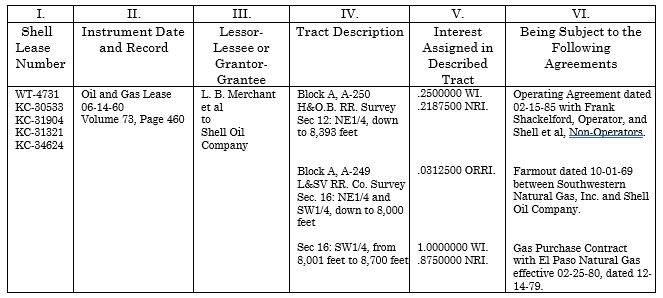
In Occidental Permian, Ltd. v. Citation 2002 Investment LLC,[1] issued on May 17, 2024, the Supreme Court of Texas ruled that an assignment of oil and gas leases was not limited by the depth references contained in the assignment’s exhibit. Below is a summary of the facts in the case and the court’s analysis in reaching its conclusion.
In 1987, Shell Western E&P, Inc. assigned numerous oil and gas leases to Citation 2002 Investment LLC’s predecessor by an assignment containing a lengthy exhibit describing the leases with six columns of information (the “Assignment”). Below is an excerpt from the Assignment’s exhibit (the “Exhibit”):

Many of the tract descriptions in Column IV of the Exhibit contain depth references, as seen in the excerpt above. Ten years later, in 1997, Shell Western purported to assign the deep rights in many of the same leases to Occidental Permian’s predecessor. Litigation ensued between Occidental and Citation, with the issue being how to reconcile the Assignment’s broad granting language with the depth notations contained in its Exhibit.
Occidental claimed that the depth references limited the conveyance to those specific depths. Citation claimed that it received Shell Western’s entire interest in the leases as to all depths. Citation argued that nothing in the Assignment or its Exhibit stated that the depth notations functioned as a reservation. According to Citation, the depth references merely identified portions of the leased land that were subject to third-party interests derived from the unrecorded agreements described in Column VI of the Exhibit. The Court agreed with Citation.
When interpreting an agreement that contains conflicts or inconsistencies, courts will seek to harmonize all of the provisions contained in the agreement in order to determine the parties’ intent, rather than relying on arbitrary or default rules of construction. In this case, the Exhibit was deemed ambiguous due to its descriptions of smaller interests without an express reservation, and its lack of instructions on how to read the tables contained therein. As a result, the Court turned to an analysis of the Assignment’s terms, including its granting clauses, in order to determine the parties’ intent. Portions of the granting clauses are included below, with certain key language shown in italics:
All of Shell Western’s right, title, and interest in and to the oil and gas fee, mineral and leasehold estates described in Exhibit A;
- All of Shell Western’s right, title, and interest in and to any contracts or agreements, including rights above or below certain footage depths or geological formations affecting the property described in Exhibit A; and
- It is the intent of this Assignment to transfer and convey to Citation all rights and interests now owned by Shell Western in the leases and other rights described herein regardless of whether same may be incorrectly described or omitted from Exhibit A.
The Court construed the broad granting language in the first and third clauses as pointing to the leases listed in Column I of the Exhibit “as the definitive identifying description of the conveyed interests." The Court interpreted the second granting clause as instructing the reader that depth references are not determinative. Further, the Court noted that unrecorded agreements are covered by a separate clause which indicates that the leases are not limited by the depth references. Ultimately, the Court concluded that the descriptions in Columns IV through VI were not intended to limit the “broad grant of leasehold estates,” but rather, they served to provide notice of “depth-specific third party interests” that continued after the transaction.
Occidental argued that the third granting clause was a “Mother Hubbard” clause that can only convey small, overlooked property interests and therefore cannot overcome Shell Western’s reservation of certain depths. The Court disagreed and referred to its decision in Davis v. Mueller[2] where it interpreted a very similar deed provision as constituting a general grant of conveyance.
Occidental also argued that the Assignment’s use of “subject-to” clauses limited the scope of the grant to the depths identified in the Exhibit. However, the Court noted that “subject-to” clauses do not necessarily limit the grant and sometimes merely provide notice of rights or obligations to which the property is subject, such as when a conveyance is subject to an outstanding oil and gas lease. The Court stated that none of the “subject-to” clauses in the Assignment limited the grant to the depths specified in the Exhibit. Rather, they served to make the Assignment subject to certain reservations found within the body of the Assignment and to the burdens created by the third-party interests described in Columns IV through VI of the Exhibit.
The Court noted the general rule that a reservation of specific interests must be explicit in an assignment conveying all of the assignor’s right, title, and interest. In this case, none of the language in the Assignment or its Exhibit expressly stated that the depth specifications in the Exhibit served any purpose other than providing notice that certain tracts and depths covered by the leases were subject to third-party interests. Thus, the depth specifications were deemed merely descriptive and did not limit the scope of the conveyance. Perhaps a different outcome would have been reached if the Assignment and its Exhibit had included grant-limiting language, such as “insofar and only insofar as the properties are described in the attached exhibit.” This case serves as a reminder of the importance of careful drafting. Attorneys and landmen should thoroughly examine and harmonize all of the language in the body of the assignment and its exhibit prior to execution.
For comparison to other assignment construction cases, see our post discussing Piranha Partners v. Neuhoff and Posse Energy, Ltd. v. Parsley Energy, LP.
[1] Occidental Permian, Ltd. v. Citation 2002 Inv., 23-0037 (Tex. May 17, 2024).
[2] Davis v. Mueller, 528 S.W.3d 97 (Tex. 2017).